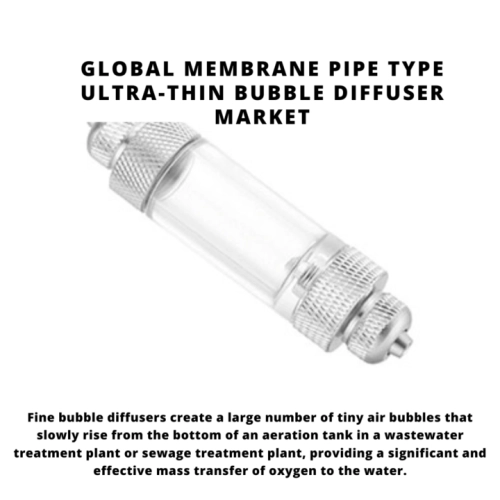
- Get in Touch with Us

Last Updated: Apr 25, 2025 | Study Period: 2022-2030
Fine bubble diffusers create a large number of tiny air bubbles that slowly rise from the bottom of an aeration tank in a wastewater treatment plant or sewage treatment plant, providing a significant and effective mass transfer of oxygen to the water. The bacteria can create enzymes that aid in the breakdown of waste so that it can settle in secondary clarifiers or be filtered by membranes thanks to the oxygen and their food source, sewage. Common shapes for a fine bubble diffuser include a tube, disc, plate, and dome.

The Global Membrane pipe type ultra-fine bubble diffuser market accounted for $XX Billion in 2021 and is anticipated to reach $XX Billion by 2030, registering a CAGR of XX% from 2022 to 2030.
A special PTFE coating on the rubber membrane is available from SSI Aeration, Inc., and it is very successful in preventing bacterial fouling and coating. Rubber expands as compressed air passes across the membrane. Thousands of bubbles are released into the water as a result of this expansion, which opens the constellation of tiny holes. Although disc diffusers are more difficult to install than other types of diffusers, they are quite effective at what they do.
A long, narrow plastic or ceramic cylinder is the main component of a tube diffuser, which is encircled by an EPDM rubber membrane. Once more, as compressed air passes through the rubber, it expands, causing the tiny holes to open and tiny bubbles to be released into the wastewater.Compared to disc diffusers, this kind of tiny bubble diffuser typically has a larger surface area and creates more bubbles. Despite being easier to install and requiring cheaper initial costs than disc diffusers, they are not always less expensive to maintain over the long term.
| Sl no | Topic |
| 1 | Market Segmentation |
| 2 | Scope of the report |
| 3 | Abbreviations |
| 4 | Research Methodology |
| 5 | Executive Summary |
| 6 | Introduction |
| 7 | Insights from Industry stakeholders |
| 8 | Cost breakdown of Product by sub-components and average profit margin |
| 9 | Disruptive innovation in the Industry |
| 10 | Technology trends in the Industry |
| 11 | Consumer trends in the industry |
| 12 | Recent Production Milestones |
| 13 | Component Manufacturing in US, EU and China |
| 14 | COVID-19 impact on overall market |
| 15 | COVID-19 impact on Production of components |
| 16 | COVID-19 impact on Point of sale |
| 17 | Market Segmentation, Dynamics and Forecast by Geography, 2022-2030 |
| 18 | Market Segmentation, Dynamics and Forecast by Product Type, 2022-2030 |
| 19 | Market Segmentation, Dynamics and Forecast by Application, 2022-2030 |
| 20 | Market Segmentation, Dynamics and Forecast by End use, 2022-2030 |
| 21 | Product installation rate by OEM, 2022 |
| 22 | Incline/Decline in Average B-2-B selling price in past 5 years |
| 23 | Competition from substitute products |
| 24 | Gross margin and average profitability of suppliers |
| 25 | New product development in past 12 months |
| 26 | M&A in past 12 months |
| 27 | Growth strategy of leading players |
| 28 | Market share of vendors, 2022 |
| 29 | Company Profiles |
| 30 | Unmet needs and opportunity for new suppliers |
| 31 | Conclusion |
| 32 | Appendix |